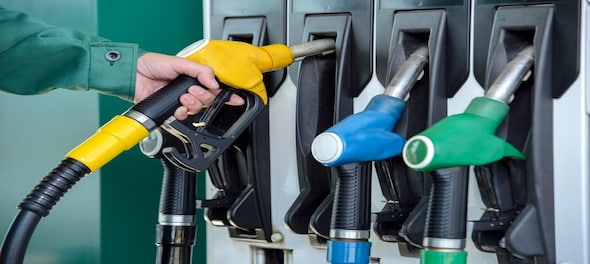
A sudden discussion has surfaced when questions were posed to Finance Minster Nirmala Sitharaman on a possible respite on high fuel prices.
The government argues that it cannot reduce fuel prices as it is bearing the burden of Oil bonds raised by the UPA government instead of giving direct subsidies to Oil Marketing companies. On the other hand, top opposition leaders such as P.Chadambaram and Veerapa Moily came out on Twitter to counter the government. So here is what government and what the opposition has to say.
How did it start?
Finance Minister Nirmala Sitharaman on August 16 in a media interaction said: “UPA govt did a trickery and raised oil bonds to facilitate a reduction in oil prices. NDA govt till date is paying off the interest and principal of these bonds. Since 2014, NDA govt has paid an interest of Rs 70195.72 cr and principal amount discharged is Rs 3500 cr”
According to govt calculation: principal outstand to be cleared till FY2026 is Rs 130923.17 cr and the interest due is Rs 37340.44 cr
Here is the Math:
| Year | Principal (Rs cr) | Interest (Rs cr) |
| FY15 | 3500 | 10255.96 |
| FY16 | 0 | 9989.96 |
| FY17 | 0 | 9989.96 |
| FY18 | 0 | 9989.96 |
| FY19 | 0 | 9989.96 |
| FY20 | 0 | 9989.96 |
| FY21 | 0 | 9989.96 |
| PAID SO FAR | 3500 | 70195.72 |
| FY22 | 10000 | 9989.96 |
| FY23 | 0 | 9195.96 |
| FY24 | 31150 | 9195.96 |
| FY25 | 52860.17 | 6226.99 |
| FY26 | 36913 | 2731.56 |
| Total | 134423.17 | 37340.44 |
FM says “ If I did not have the burden to service the Oil bonds, I would have been in a position to reduce fuel excise”
But, is this what the opposition agrees with?
Well here is what top opposition leaders have to say to counter this argument:
On August 17 , Former Finance Minister P Chidambaram in a series of tweets said:
“The FM’s statement that servicing oil bonds stands in the way of giving relief on petrol and diesel prices is astonishing. At best the statement is incredible ignorance; at the worst, it is motivated malignity. If the UPA government wanted to subsidise fuel prices, it had the choice of finding the money by borrowing directly or asking the oil companies to borrow. In either case, servicing the loan (interest) would be the responsibility of the central government. Every analyst and every lender knew that oil companies borrowed as a surrogate of the central government and mentally added the borrowing to the fiscal deficit. Having profited several times over through exorbitant taxes and cesses on fuel, the NDA has no right to comment on the fuel subsidy. The people know that UPA gave them relief and the NDA is crushing them through oppressive taxes and cesses.”
Even former Petroleum Minister Veerapa Moily countered Finance Minister Nirmala Sithraman and in a series of tweets on August 18 said:
“On the oil bonds issued by UPA, the NDA government has to repay Rs 1.31 lakh crores by 2025-26.
On an accumulated basis this is far less than what the government collects from central excise duties on petroleum products alone (thereby burdening the consumers with high fuel prices).
In 2020-21, the NDA Govt collected Rs 3.71 lakh crore as central excise revenues from petroleum products, nearly three times what it has to pay—Rs 1.34 lakh crore by 2025-26. So why blame the UPA?”
So what is the solution? How soon, or how can the common man get some respite from high fuel prices?
Well! here is what was suggested by Finance Minister herself:
FM during the August 16 interaction said: Both centre and states levy taxes on fuel retail. “Fuel is under the ambit of GST but with no rate, leaving that option open…Both centres and states will have to sit and talk to find a solution for oil bonds. Unless centre and states discuss the way out there is no solution possible on price cut”
So what do we as consumers need to now watch out for?
Let’s see how soon both states and centres decide to meet over this subject. Secondly, whether the upcoming GST Council sees any discussion to begin talks on deciding the rates for fuel so that it can be covered under GST, subsuming all state and central taxes. However, a challenge here is that both states and centres are using revenues coming from fuel to funds increased expenses during challenging covid times, on health infrastructure and services.
First Published: Aug 19, 2021 7:17 PM IST
Check out our in-depth Market Coverage, Business News & get real-time Stock Market Updates on CNBC-TV18. Also, Watch our channels CNBC-TV18, CNBC Awaaz and CNBC Bajar Live on-the-go!


PM Modi, Rahul Gandhi election rallies in Delhi today: Here are the routes to avoid
May 18, 2024 11:28 AM
Celebrity Kangana vs 'royal' Vikramaditya on Himachal's Mandi seat: Clash of richest titans
May 18, 2024 11:11 AM
2024 Lok Sabha Elections | Will Amethi and Rae Bareli see the rise of Priyanka Gandhi as a dominant political figure
May 18, 2024 8:59 AM
Lok Sabha Election 2024: I.N.D.I.A. bloc to hold rally at Mumbai's BKC today
May 17, 2024 5:18 PM

